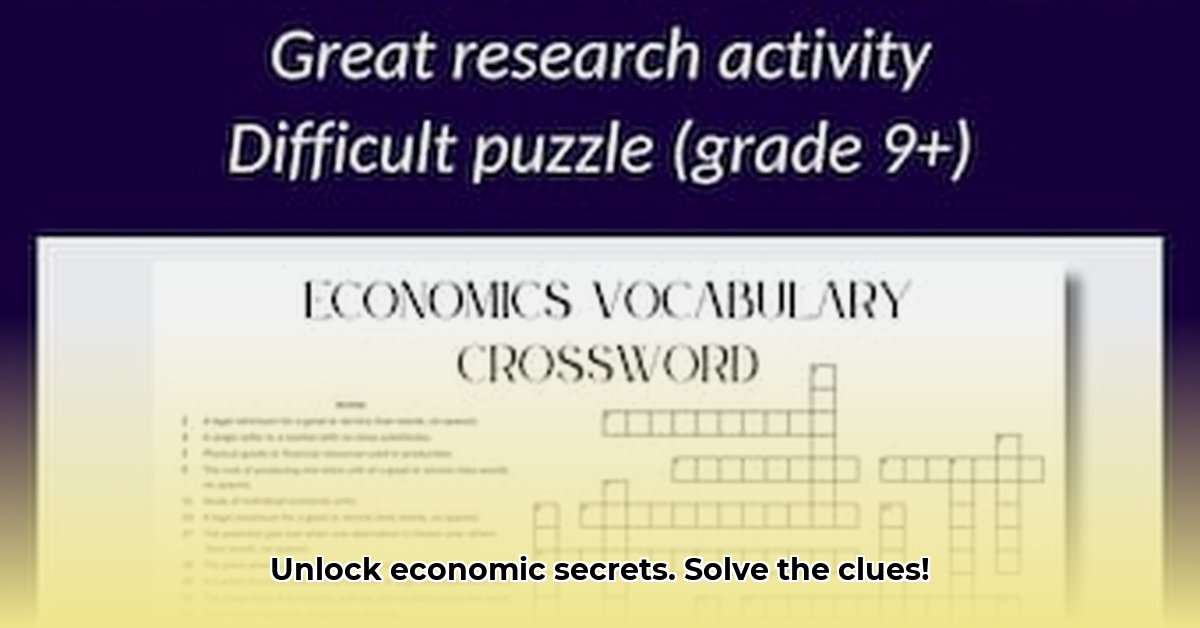
Scarcity: From Crossword Clue to Economic Principle
Ever been stumped by a crossword clue simply stating "Scarcity"? While seemingly straightforward, this word unlocks a surprisingly complex world—the core principle of economics. This article explores the fascinating contrast between the simple representation of scarcity in crossword clues and the intricate economic models used to understand it. We'll delve into how economists view scarcity, demonstrating how a basic crossword puzzle can illuminate a fundamental economic concept. But be warned: the simple answer to the crossword clue is just the tip of the iceberg. For a more in-depth look at crossword clues related to economics, check out this helpful resource.
Beyond "Shortage": Unpacking the Economic Definition of Scarcity
A typical crossword clue might yield answers like "shortage," "dearth," or "lack," accurately reflecting the basic notion of insufficient resources. However, economists define scarcity more profoundly. It's not merely a lack, but the fundamental economic problem: unlimited human wants colliding with limited resources. This necessitates choices, trade-offs, and careful resource allocation. Think about it: a town with a limited budget must choose between building a new library or repairing its roads—they can’t do both. How does understanding this fundamental trade-off inform better decision-making in various sectors?
Markets and Scarcity: The Dance of Supply, Demand, and Price
Economic models illustrate how markets dynamically respond to scarcity. When resources are limited, prices rise, signaling both consumers and producers to adapt. Higher prices encourage people to use resources more efficiently, while also motivating businesses to increase supply or develop substitutes. This intricate interplay—absent from a simple crossword solution—is how markets allocate scarce resources. Isn't the market's ability to adjust to scarcity a testament to its adaptability? This is far more complex than a simple synonym for "scarcity."
Absolute vs. Relative Scarcity: Nuances of Limited Resources
Economists further distinguish between absolute scarcity (a complete lack of a resource, like clean air in a severely polluted region) and relative scarcity (enough of a resource to meet basic needs, but not everyone's wants, such as a limited-edition collectible). Can you think of examples of both absolute and relative scarcity in your daily life? A crossword clue, however, doesn't differentiate between these crucial types. A simple "lack" doesn't convey the depth of this distinction.
Bridging the Gap: From Crossword Clue to Comprehensive Economic Models
The stark contrast between a simple crossword clue and sophisticated economic models highlights the difference between basic understanding and comprehensive analysis. The clue provides a surface-level definition; economic models delve into the underlying mechanisms that govern scarcity's impact on individuals, markets, and the entire economy. Does this contrast highlight the need for a more holistic approach to understanding economic concepts?
Putting Scarcity Insights to Work: Practical Applications Across Sectors
Understanding scarcity isn't merely an academic exercise; it has significant practical implications.
Businesses: Efficient resource allocation, inventory management, and proactive supply chain strategies hinge on understanding scarcity. Effective forecasting based on the principle of scarcity can mitigate disruptions.
Governments: Policy-making requires careful consideration of resource allocation and the potential consequences of policies on different societal groups. Fairness and efficiency are paramount when resources are limited.
Individuals: Daily decisions involve constrained budgets, limited time, and diverse choices. A better understanding of scarcity helps individuals make informed choices that align with their goals.
Economists: Ongoing research continuously refines economic models by integrating additional complexities such as behavioral economics and psychological factors. This ensures models adapt to real-world phenomena.
"The study of scarcity demands a nuanced understanding of both its theoretical underpinnings and its practical consequences," says Dr. Anya Sharma, Professor of Economics at the University of California, Berkeley. "It’s not just about a lack; it's about the choices we make with limited resources."
How Economists Model Scarcity: A Deeper Dive
While a crossword clue simply labels scarcity, economists build complex models. They recognize that scarcity isn't a static condition but a dynamic force shaping individual choices, market behavior, and overall economic outcomes.
From Simple Words to Sophisticated Equations
Economists employ various tools like supply and demand curves, production possibility frontiers, and cost-benefit analyses. These are mathematical representations showing how scarcity affects prices, production, and consumer behavior. These models aren't simple definitions; they’re rigorous frameworks analyzing complex interactions.
The Human Factor: Decisions Under Scarcity
Economic models incorporate the human element—the decisions made under scarcity. These choices influence resource allocation, consumption, and even national economic policy. They examine how people react to price changes, assessing value and affordability.
Predicting the Future: Forecasting Scarcity's Impact
Economists use models to predict future scarcity, analyze policy implications, and devise solutions. They study factors like population growth and technological advancement to anticipate future resource availability. This proactive approach is absent from the simple snapshot of scarcity provided by a crossword clue.
The simple crossword clue directs us to the basic idea of scarcity. However, economic models illuminate its intricate dynamics, offering a far more comprehensive and insightful understanding. The puzzle offers a single word; economics offers a complete theory.